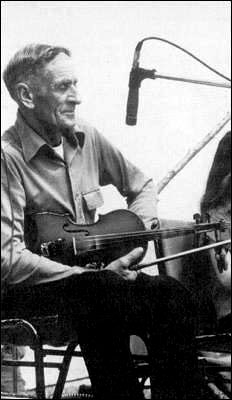Zélie-Anne Poirier
Kith Folk
Zélie-Anne Poirier, also known as Zélianna à Jos Bibienne. She was born September 2, 1922 in St. Nicholas, PEI the second youngest daughter and one of 14 children of Joseph B. Arsenault and Julie-Anne LeClair of Egmont Bay. Joseph B had been previously married to Bibienne Arsenault. Joseph was a fiddler and Julie played pump organ and step-danced. They were poor but there was always music. Zélie said that “I was so dang poor I was born bare naked, and you can’t get any poorer than that.” She learned to step dance and play the fiddle when she was 7 or 8 years old, as well as playing the mouth organ, the piano, the pump organ as well as some guitar and accordion. Zélia and her sisters were the first women on PEI to perform in public.
Amand Arsenault kick up his heels while Zélie-Anne fiddles and Georges Arsenault looks on.















